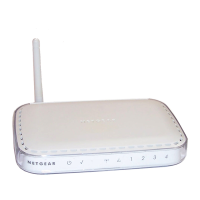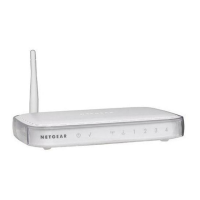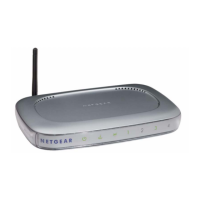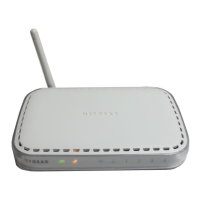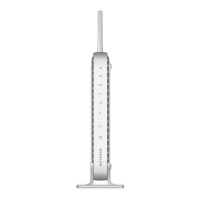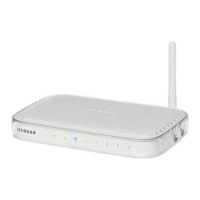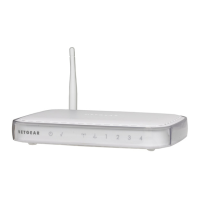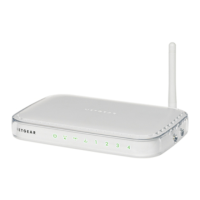Do you have a question about the NETGEAR WGR614 v6 and is the answer not in the manual?
Defines the manual's intended audience, scope, conventions, and formats for clarity.
Explains how to navigate and utilize the HTML version of the manual.
Provides instructions for printing pages, chapters, or the full manual.
Lists and briefly describes the main functionalities of the WGR614 v6 router.
Details the 802.11g wireless networking capabilities and features of the router.
Explains the router's firewall capabilities and content filtering features for security.
Outlines the security features implemented in the WGR614 v6 router.
Highlights features that simplify the setup and daily operation of the router.
Describes the status lights and indicators on the front panel of the WGR614 v6.
Identifies the ports and features located on the rear panel of the WGR614 v6.
Guides users through the initial setup process using the Smart Wizard.
Provides steps to access and log into the router's configuration interface.
Details how to configure the router's Internet connection parameters.
Guides users on configuring wireless network parameters like SSID, channel, and security.
Lists the default configuration settings of the router before customization.
Provides an overview of the router's content filtering capabilities and features.
Details how to restrict access to specific websites or content using keywords.
Explains how to block specific internet services or port filtering.
Explains how to set schedules for content filtering and service blocking.
Describes how to view logs of web access and attempted access for monitoring.
Explains how to view the router's current status, including network and wireless port information.
Guides on downloading and installing new firmware for the router.
Details how to change the router's login password for enhanced security.
Explains how to set up port triggering for gaming and internet applications.
Guides on making local servers accessible to the internet via port forwarding.
Covers WAN setup options like DMZ server, MTU size, and Ping response.
Explains how to configure the router to act as a DHCP server for the network.
Details how to configure dynamic DNS for accessing the network remotely.
Guides on allowing remote access to the router's management interface.
Provides steps to resolve issues accessing the router's web-based configuration.
Details steps to diagnose and resolve problems with the internet service connection.
Explains how to restore the router to its factory default settings and password.
Lists the network protocols and standards the router supports.
Provides the physical dimensions and weight of the router.
Lists technical specifications related to the router's wireless capabilities.
Explains fundamental concepts related to router functionality and networking.
Explains IP address structure, classes, and their use on the internet.
Explains the function and format of netmasks in IP addressing.
Discusses the importance of firewalls for network security against external threats.
Provides information on Ethernet cabling standards and wiring.
Lists the parameters needed to connect the router to the internet service.
Provides a template to record ISP-provided internet connection details.
Details TCP/IP configuration steps for Windows 95, 98, and Me operating systems.
Provides steps for configuring TCP/IP with DHCP in Windows XP.
Details TCP/IP configuration for Macintosh computers using DHCP.
Explains how to check if the internet account and modem are ready.
Guides on collecting ISP configuration details from Windows computers.
Provides a general overview of wireless networking standards and technologies.
Explains the infrastructure mode of wireless LAN operation.
Discusses wireless authentication methods and WEP data encryption.
Introduces WPA and WPA2 as advanced wireless security standards.
Compares WPA security features with WEP, highlighting WPA's advantages.
Defines the IEEE 802.11 standard for wireless local area networks.
Explains AES as an advanced encryption standard for wireless security.
Defines an Access Point (AP) as a wireless transceiver or base station.
Explains DHCP for dynamic IP address assignment on a network.
Defines NAT for dynamically sharing a single IP address among multiple computers.
Defines WEP as basic wireless security.
Defines WPA as an improved security technology over WEP.
Defines the manual's intended audience, scope, conventions, and formats for clarity.
Explains how to navigate and utilize the HTML version of the manual.
Provides instructions for printing pages, chapters, or the full manual.
Lists and briefly describes the main functionalities of the WGR614 v6 router.
Details the 802.11g wireless networking capabilities and features of the router.
Explains the router's firewall capabilities and content filtering features for security.
Outlines the security features implemented in the WGR614 v6 router.
Highlights features that simplify the setup and daily operation of the router.
Describes the status lights and indicators on the front panel of the WGR614 v6.
Identifies the ports and features located on the rear panel of the WGR614 v6.
Guides users through the initial setup process using the Smart Wizard.
Provides steps to access and log into the router's configuration interface.
Details how to configure the router's Internet connection parameters.
Guides users on configuring wireless network parameters like SSID, channel, and security.
Lists the default configuration settings of the router before customization.
Provides an overview of the router's content filtering capabilities and features.
Details how to restrict access to specific websites or content using keywords.
Explains how to block specific internet services or port filtering.
Explains how to set schedules for content filtering and service blocking.
Describes how to view logs of web access and attempted access for monitoring.
Explains how to view the router's current status, including network and wireless port information.
Guides on downloading and installing new firmware for the router.
Details how to change the router's login password for enhanced security.
Explains how to set up port triggering for gaming and internet applications.
Guides on making local servers accessible to the internet via port forwarding.
Covers WAN setup options like DMZ server, MTU size, and Ping response.
Explains how to configure the router to act as a DHCP server for the network.
Details how to configure dynamic DNS for accessing the network remotely.
Guides on allowing remote access to the router's management interface.
Provides steps to resolve issues accessing the router's web-based configuration.
Details steps to diagnose and resolve problems with the internet service connection.
Explains how to restore the router to its factory default settings and password.
Lists the network protocols and standards the router supports.
Provides the physical dimensions and weight of the router.
Lists technical specifications related to the router's wireless capabilities.
Explains fundamental concepts related to router functionality and networking.
Explains IP address structure, classes, and their use on the internet.
Explains the function and format of netmasks in IP addressing.
Discusses the importance of firewalls for network security against external threats.
Provides information on Ethernet cabling standards and wiring.
Lists the parameters needed to connect the router to the internet service.
Provides a template to record ISP-provided internet connection details.
Details TCP/IP configuration steps for Windows 95, 98, and Me operating systems.
Provides steps for configuring TCP/IP with DHCP in Windows XP.
Details TCP/IP configuration for Macintosh computers using DHCP.
Explains how to check if the internet account and modem are ready.
Guides on collecting ISP configuration details from Windows computers.
Provides a general overview of wireless networking standards and technologies.
Explains the infrastructure mode of wireless LAN operation.
Discusses wireless authentication methods and WEP data encryption.
Introduces WPA and WPA2 as advanced wireless security standards.
Compares WPA security features with WEP, highlighting WPA's advantages.
Defines the IEEE 802.11 standard for wireless local area networks.
Explains AES as an advanced encryption standard for wireless security.
Defines an Access Point (AP) as a wireless transceiver or base station.
Explains DHCP for dynamic IP address assignment on a network.
Defines NAT for dynamically sharing a single IP address among multiple computers.
Defines WEP as basic wireless security.
Defines WPA as an improved security technology over WEP.
| Model | WGR614 v6 |
|---|---|
| Category | Wireless Router |
| Wireless Standard | 802.11g |
| Wireless Speed | 54 Mbps |
| Frequency Band | 2.4 GHz |
| LAN Ports | 4 x 10/100 Mbps |
| WAN Port | 1 x 10/100 Mbps |
| Security | WEP, WPA, WPA2 |
| Firewall | NAT |
| Weight | 0.66 lbs |
